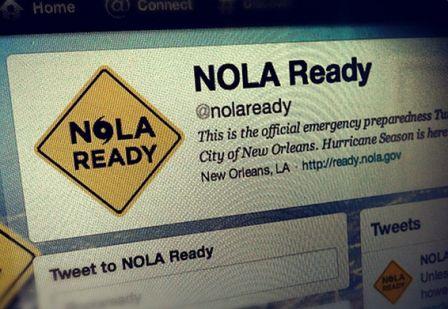Hurricane Isaac will make its appearance on the northern shore of the Gulf of Mexico shortly. For those of us in the Northeast, we are lucky to be waiting safely in the sunshine. However, with Hurricane Katrina still fresh in the minds of many people in the Gulf, particularly residents of New Orleans, preparation is essential for big storms like Isaac.
So, New Orleans has created a NOLA Ready website and Twitter account, according to PR Daily, in order to get information out as it becomes available. These days, social media channels make it easier to spread word of what's happening now, compared with when Katrina hit in 2005.

"If the storm does something incredibly crazy, we will react to that, but at this moment there is no plan to evacuate the City of #NOLA," one tweet announced Monday, followed by a quote from Mayor Mitch Landrieu that read, "If you plan to leave, you feel comfortable leaving and you have a place to go, don't wait. Now would be a good time to go."
Local communications professionals have said city and state social media efforts for the emergency have been handled very well.
"The updates are engaging, informative, and timely. The profiles also respond to questions and statements easily and quickly," Sara Estes Cohen, an emergency response and social media strategist in New Orleans, told PR Daily.
Many responses to citizens have come from the mayor's Twitter (News - Alert) account to correct misinformation, while the NOLA Ready account has been answering questions about closings and transit changes. Additionally, the state's Twitter account for the Governor's Office of Homeland Security and Emergency Preparedness has stayed on top of things.
Tripp Frohlichstein of MediaMasters Training said this is effective for a large percentage of people in the area, but it there are also a lot of people that don't have access to social media, or simply don't use it. “So it is important they also use traditional electronic media to keep people updated,” he said.
According to Jeff Zehnder of New Orleans-based Zehnder Communications, the mayor's office has done "a stellar job" coordinating communications officials to get information out through social media.
On the other hand, though the city's social media efforts are thorough, Frohlichstein said they could be more personal. "Perhaps it is implied, but I think it would enhance the efforts of the local and state governments to note that everything they are doing is to keep people safe.”
For instance, a tweet from the governor's emergency preparedness office read, "Gov @BobbyJindal: Authorized activation of up to 4,000 LA Nat'l Guardsmen if necessary for #Isaac; 700 fulltime Guardsmen working today."
Communications Strategist and former CBS News Correspondent David Henderson said he sees the NOLA Ready site and the Twitter accounts as mostly self-serving. "The website is too wordy, too generic, and too politically correct by presenting all the press releases of the various politicians," he explained.
Similarly with the Twitter accounts, Henderson said, as most New Orleans residents will be getting their news by radio. Since Internet penetration in the region is considerably below the national norm, social media is even less effective for reaching people in the area.
In order to alleviate this communication challenge, the FCC (News - Alert) and FEMA have provided the public with helpful tips to follow for communicating during an emergency. These emergency tips include:
- Limit non-emergency phone calls to minimize network congestion for emergency communications and conserve battery power.
- Keep calls brief and only use a phone to convey vital information to emergency personnel or family.
- For non-emergency calls, use text messaging because texts go through calls may not, freeing up space on the network.
- Try a variety of communications to get through in an emergency. Also, try a landline phone because it will spread the communications demand over multiple networks and reduce congestion.
- Wait 10 seconds before redialing a call because the data from the wireless phone to the cell sites need time to clear before resending the same data.
- If in a vehicle, place calls while the vehicle is stationary.
- Use Call Forwarding from your home number to your wireless number so you will get calls from your landline phone in case of evacuation.
- If your home doesn’t have power use your car to charge cell phones or listen to news on the radio.
Want to learn more about the latest in communications and technology? Then be sure to attend ITEXPO West 2012, taking place Oct. 2-5, in Austin, TX. Stay in touch with everything happening at ITEXPO (News - Alert). Follow us on Twitter.
Edited by Rich Steeves
 Internet Telephony Magazine
Click here to read latest issue
Internet Telephony Magazine
Click here to read latest issue CUSTOMER
CUSTOMER  Cloud Computing Magazine
Click here to read latest issue
Cloud Computing Magazine
Click here to read latest issue IoT EVOLUTION MAGAZINE
IoT EVOLUTION MAGAZINE




